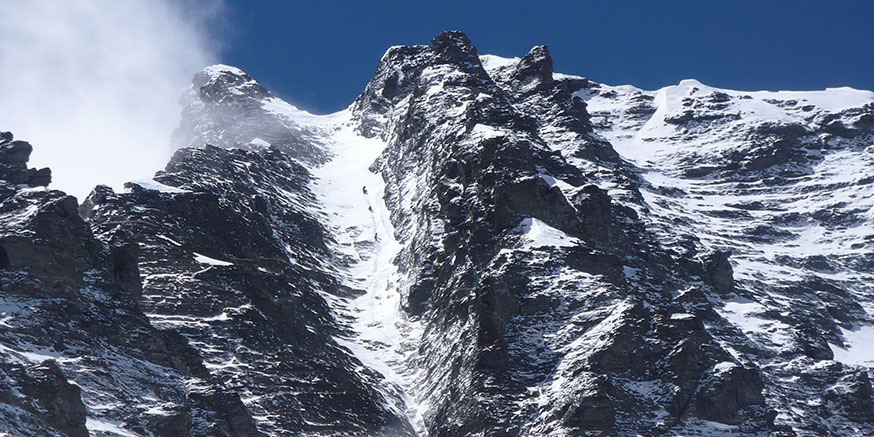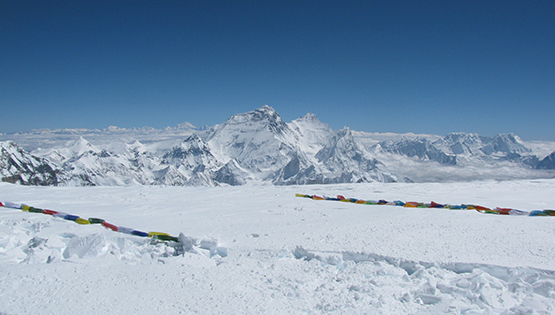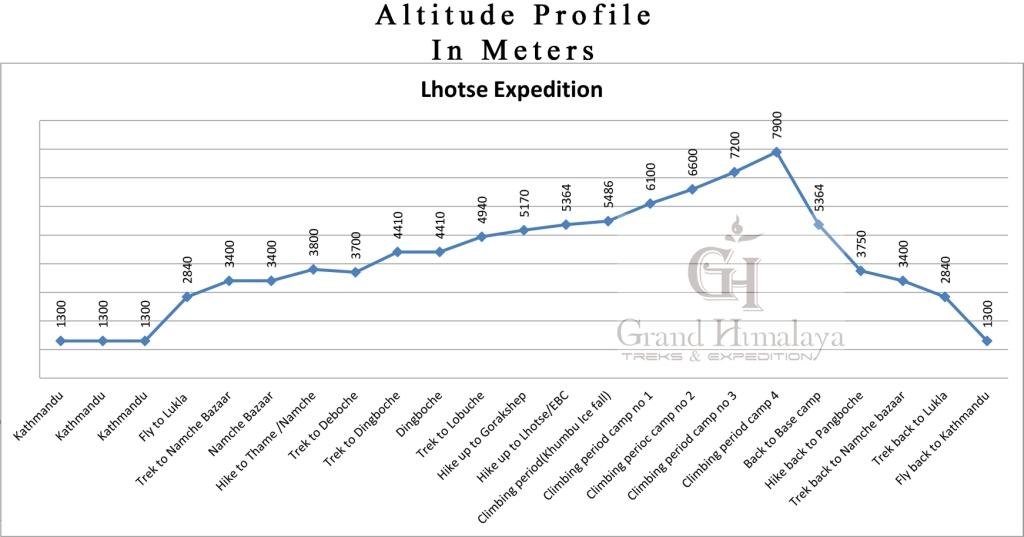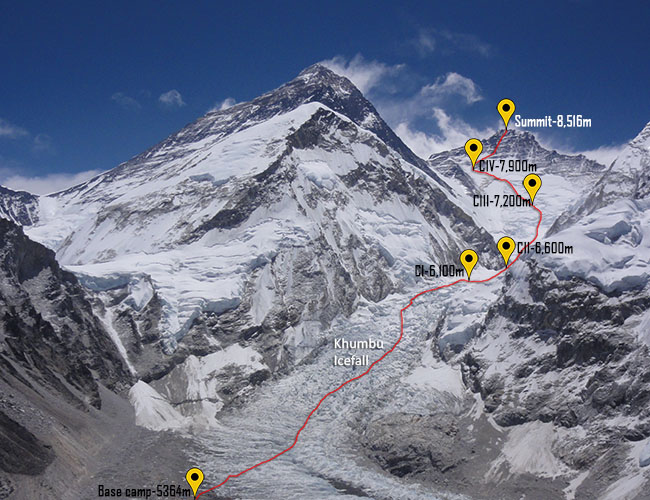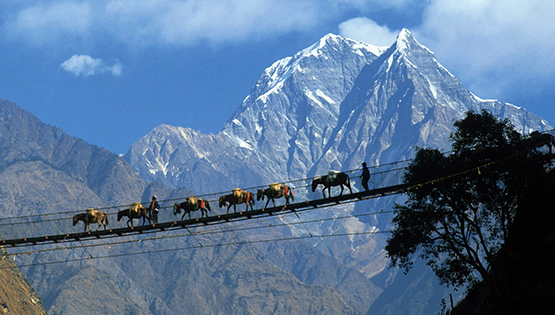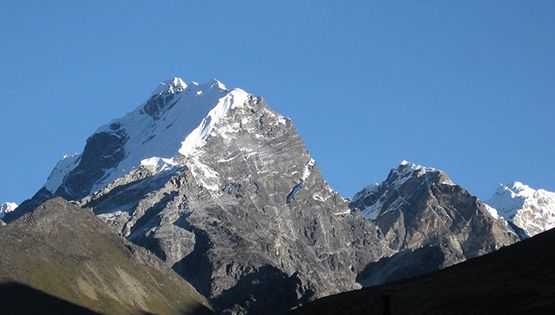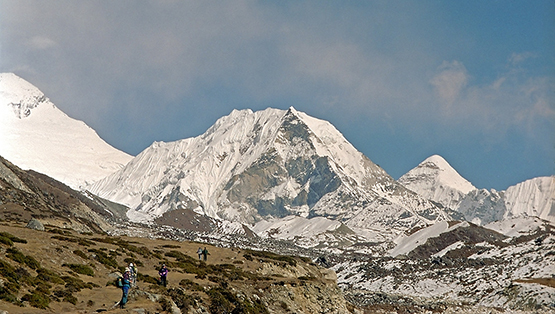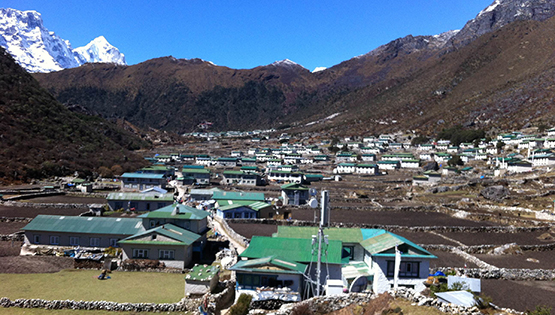Lhotse in Tibetan or Sherpa term means the south summit/peak. Mt. Lhotse is sometimes mistakenly identified as the south peak of the Everest massif.
No serious attention was turned to climbing Mt. Lhotse until after Everest had finally been ascended. Mt. Lhotse was first climbed in 1956 as an alternative route to the summit of Everest.
It is the fourth highest mountain on Earth (after Mount Everest, K2 and Kanchenjunga) and its long east-west crest is located immediately south of Mount Everest (8848m/29,029ft) and the South Col, a vertical ridge that never drops below 8,000 meters, connects the summits of the two mountains.
It is connected to Everest via the South Col. In addition to the main summit at 8,516 metres (27,940 ft) above sea level, Lhotse Middle (East) is 8,414 metres (27,605 ft) and Lhotse Shar is 8,383 metres (27,503 ft).
It is located at the border between Tibet (China) and the Khumbu region of Nepal.
Lhotse is best known for its proximity to Mt. Everest and the fact that climbers ascending the standard route on that peak spend some time on its northwest face. In fact Lhotse has the smallest topographic prominence value of any official eight-thousander, as it rises only 610 m (2,000 ft) above the South Col.
Hence it is often seen as a minor eight-thousander. However, Lhotse is a dramatic peak in its own right, due to its tremendous south face. This rises 3.2 km (2.0 mi) in only 2.25 km (1.4 mi) of horizontal distance, making it the steepest face of this size in the world.
The south face has been the scene of many failed attempts, some notable fatalities and very few ascents (one of them, by Tomo Cesen, unverified).The main summit of Lhotse was first climbed on May 18, 1956 by the Swiss team of Ernst Reiss and Fritz Luchsinger from the Swiss Mount Everest/Lhotse Expedition.
On May 12, 1970, Sepp Mayerl and Rolf Walter of Austria made the first ascent of Lhotse Shar. Lhotse Middle remained, for a long time, the highest unclimbed named point on Earth; on May 23, 2001, its first ascent was made by Eugeny Vinogradsky, Sergei Timofeev, Alexei Bolotov and Petr Kuznetsov of a Russian expedition.
The Lhotse standard climbing route follows the same path as Everest's South Col route up to the Yellow Band beyond Camp 3. After the Yellow Band the routes diverge with climbers bound for Everest taking a left over the Geneva Spur up to the South Col, while Lhotse climbers take a right further up the Lhotse face. The last part to the summit leads through a narrow couloir until the Lhotse main peak is reached.
A very warm welcome to the Kingdom of Himalayas. Upon your arrival at the Tribhuvan international airport our representative welcomes you and assists you transfer in your hotel in Kathmandu. After time to get refreshed, evening you'll meet and transfer for welcome dinner in one of the typical Nepalese restaurant in the heart of Kathmandu i.e. Utsav or Nepali Chula (Kitchen). Here you will not simply experience the traditional Nepalese dish but will be entertained with Nepalese traditional dance and folk songs. After the dinner, you will be transferred back to your respective hotel.
Preparation for Everest Expedition; the leader has to attend a formal briefing in the Ministry of Tourism. The day will also be for finalizing official procedure and other necessary arrangements. You will be also briefed on the nature of expedition, equipments and team composition. You can also make your last minute buying of personal items as you will be flying to the Himalayas day after tomorrow. In the late afternoon, the leader will check everyone's equipment, as Kathmandu is the last opportunity to buy anything missing. You will also get introduced with fellow expedition members and guides. Overnight at Hotel.
Kathmandu is the historical and cultural heart of Nepal and has been a popular destination for tourists ever since Nepal opened its doors to visitors. The city presents a wonderful mix of Hinduism, Tibetan Buddhism and Western influence in the Valley. Bauddhanath: Stupa with its’ 130 ft. dome. One of the world’s largest Stupa, Bouddha is generally acknowledged to be the most important Tibetan Buddhist monument outside Tibet. Pupshupatinath Temple: Pashupatinath is considered one of the holiest shrines of all the Hindu temples. The temple has remained the presiding deity of ruling Nepalese Royalty. Swayambhunath: Three kilometres west of Kathmandu city complex locates the one of the world’s most glorious Buddhist Stupas, it is said to be 2000 years old. Visitors often call it "Monkey Temple". -After the city tour, our leader or guide will do the final briefing of the expedition. They will also take the opportunity to check the members' personal equipment as the city bazaars and climbing shops will provide the last chance to correct any deficiencies. Overnight at Hotel.
It's a panoramic thrill flying into Lukla in a Twin Otter plane on a clear day. The views of snow-capped mountain peaks sprawling around you outside your plane are almost ecstatic, beginning a whole chain of memorable experiences that stay with you for a long, long time. This is an exciting flight, which should give a glimpse of Everest in the distance. In Lukla, we will meet our trek staffs and porters and set off straightaway for our first night's stop at Phakding 2600m. Situated on the banks of the Dudh Kosi, which drains the whole of the Khumbu Region, this small hamlet is on the main trade route through the area and there are a number of clean, well-built lodges where we can spend the night.
We will continue up the banks of the Dudh Kosi, crossing it twice by small suspension bridges before reaching the village of Monjo where we will enter the Khumbu National Park. We will then cross the confluence of the Dudh Kosi and the Bhote Kosi on a high suspension bridge and climb steeply for about two hours up 'Namche Hill' to reach Namche Bazaar (3,400m/11,155ft). This is a prosperous trading town and the capital of the Khumbu Region. Many Tibetans cross the nearby border to trade their wares and the local market is a fascinating spectacle. This is a good place to buy genuine Tibetan artefacts. Just across the valley to the east stand the peaks of Thamserku and Kangtega, both very impressive mountains.
Namche Bazzar is the highlight of EBC trek and the heart of the Everest (Khumbu) region which has government offices, ATMs, Internet cafes, shops, restaurants, a bakery and a colourful market each Friday evening and Saturday. This is first scheduled 'acclimatization' day for this trek. Health experts always recommend us to stay active and moving during the rest day too instead of being idle. If we trek few hundred meters vertical during the day, it will help us to acclimatize with the alien heights that we are going to confront on the trek. Having been born, guiding and leading trips in the Himalayas, we believe in the natural process of acclimatization, "Climb high, sleep low". We take an interesting side trip up to Khumjung and climb up to famous airstrip at Syangboche. Just above the airstrip is the Everest View Hotel (3800m), a Japanese scheme to build a deluxe hotel with great views of the highest mountains on Earth. The Khumjung valley surrounded by the snowy peaks of Kongde and Thamserku, and the sacred peak the Khumbiyul-lha hosts a well known monastery that houses a yeti scalp. Visit Hillary School which is at the same site and spending some time in Khumjung after having lunch there, we walk back down to Namche Bazaar. Overnight in Namche Bazaar.
Thame (3,844m) is located west of the main Khumbu Valley. It is famous as being the birthplace of Tenzing Norgay, the first person to set his foot on the summit of Mt. Everest with Edmund Hillary in 1953. We may meet Tibetans, who have crossed over the high passes from Tibet called Nangpa La pass, coming down the valley to trade their goods in Namche Bazaar. Today we will take a leisurely walk towards Thame, to further aid our acclimatisation, before continuing the following day up the main Everest Trail. Always stay alert and keep your eyes all around you because walking through the woods en route to Thame is largely inhabited by National bird of Nepal, Impeyan pheasant. The walk to Thame is mostly flat and gentle uphill climbs, and there are superb views of the surrounding peaks. If the time permits then we'll quickly pay a visit to the oldest Monastary in the Khumbu valley at Thame. We'll retrace our path back to Namche for the overnight and it's around 7 hours back to back.
From Namche, the well-worn Everest trail contours around the side of the valley high above the Dudh Kosi. As we follow the path, we will get our first really good views of the great peaks of the Khumbu: Everest, Lhotse, Nuptse and Ama Dablam. Passing by several villages and numerous tea shops, we will cross the Dudh Kosi River and make a steep climb to Tyangboche, home of an impressive and recently rebuilt monastery. We have plenty of time to look around Tyangboche (and have a cake at the bakery!), but at the height of the season it is a busy place, so we will drop down to the river and the village of Deboche (3,700m/12,135ft) a little further along the trail, where we will stay in a relaxing lodge.
Shaded by rhododendron trees, the trail crosses an airy suspension bridge just beyond Deboche. An hour's walking from here will bring us to Pangboche, an excellent viewpoint for Ama Dablam ('Mother's Charm Box') and home for the Sherpas who work on this imposing mountain each post-monsoon season. Contouring up the valley side, we will re-cross the river and turn up the Imja Valley to reach the picturesque farming village of Dingboche (4,410m/14,465ft).
It is very important to spend an additional night here to aid to the acclimatization process. Dingboche is a good location for acclimatisation, prior to our ascent up the upper section of the Khumbu Valley. It can be along a short hike of 400 meters climb to the Nangkartshang Gompa (Monastary) on the ridge, to the north of Dingboche village. From here we can catch a good view of Mt. Makalu (8463m) and the great views up the Khumbu and Imja Valleys. On the way back from acclimatisation hike, we can also attend a seminar about high altitude acclimatisation at the hospital in nearby Pheriche, run by the Himalayan Rescue Association.
We will retrace our steps back to Pheriche before continuing along the trail up the broad valley bottom towards Dugla. Ahead of us is the trekking peak of Lobuje East (6,119m/20,075ft), which is one of the objectives on our Khumbu Climber itinerary, and to our left is the formidable north face of Taweche, the scene of many cutting-edge Himalayan ascents of the 1980s and 1990s. After three hours we reach the small collection of lodges at Dugla (4,620m/15,153ft). We might choose to walk up to the Sherpa memorials, from where there are outstanding views of Ama Dablam, Cholatse and Taweche. From Dugla, the trail starts steeply to climb up beside the glacier moraine. After a few hours the track eventually leads to a small cluster of tea houses pleasantly situated at Lobuche (4,910m/16,207ft).
The first section of the trail from Lobuche follows the narrow gap between the glacial moraine and the mountain walls, past turn off to the Italian pyramid. Take time to detour to the edge of moraine to look over the Khumbu glacier. Along windy and rocky path with the wonderful view of Mt. Pumori, Nuptse and other magnificent peaks, we reach Gorakshep. Gorakshep is the location of the original Everest Base Camp with the new camp being further up the valley.
After Breakfast our adventure continues towards Lhotse/Everest Base Camp. The trail passes through over rocky dunes and moraine and streams. Climbers will often spend 4 - 8 weeks at Everest Base Camp, acclimatizing to the altitude. During that time, the "Icefall Doctors" will set up ropes and ladders in the notoriously unstable Khumbu Icefall. Seracs, crevasses and shifting blocks of ice make the icefall one of the most dangerous sections of the route.
The Khumbu Icefall is the most technically demanding portion of the climb, and is encountered right out of base camp. Here, many climbers and Sherpas have been killed in this section. To reduce the risk, climbers will usually begin their ascent well before sunrise when the freezing temperatures glue ice blocks in place. Skills required include the ability to ascend and rappel vertical to overhanging fixed lines. A special team of Sherpa’s will establish and maintain the route through the icefall. This team will span numerous crevasses with ladder bridges. Above the icefall, most of the route is equipped with fixed lines, with the exception of large flat and crevasses-free areas in the western CWM. Above the icefall is Camp I at 6,100m (20,015ft) Camp 1 is mostly a temporary camp with most climbers just spending one night at this camp.
After the Icefall, the climbers arrive at Camp I, which is located at 19,500 feet. Depending on the type of expedition, Camp I will either be stocked by the climbers as they ascend and descend the Icefall or by Sherpas in advance. The area between Camp I and Camp II is known as the Western Cwm. As the climbers reach Camp II at 21,000 feet, they may be temporarily out of sight of their support at Base camp. Nonetheless, modern communication devises permit the parties to stay in contact.
As the climbers leave Camp II, they travel towards the Lhotse face (Lhotse is a 27,920 foot mountain bordering Everest). The Lhotse face is a steep, shiny icy wall. Though not technically extremely difficult, one misstep or slip could mean a climber's life. Indeed, many climbers have lost their lives through such mishaps.
To reach Camp III, climbers must negotiate the Lhotse Face. Climbing a sheer wall of ice demands skill, strength and stamina. It is so steep and treacherous that many Sherpas move directly from Camp II to Camp IV on the South Col, refusing to stay on the Lhotse Face.
The Lhotse standard climbing route follows the same path as Everest's South Col route up to the Yellow Band beyond Camp 3. After the Yellow Band the routes diverge with climbers bound for Everest taking a left over the Geneva Spur up to the South Col, while Lhotse climbers take a right further up the Lhotse face. The last part to the summit leads through a narrow couloir until the Lhotse main peak is reached.
After Camps III and IV are established and all our supplies are in place, we'll return to Base Camp for a rest. At Base Camp, we'll organize our summit teams and prepare ourselves for summit attempts. Once we are ready, we'll return to Advanced Base. If good weather prevails, we'll move the summit team to Camp III. On the next day, the summit team moves up to Camp IV. Once at Camp IV, we'll take a rest day. We have found that this rest at Camp IV greatly increases our chances of summit success. The following day will be summit day. We start very early that morning and attempt to reach the summit before midday. After the summit, the team retreats back to the South Col and next day descends to Camp II. Guides and Sherpa will accompany all summit attempts and oxygen will be used.
It is a moment of infinite joy and honour to be back to base camp sound and hearty, and seeing all those happy familiar faces of our kitchen crews greeting and felicitating us. It's a day to celebrate with the entire team and to thank our valiant Sherpas for their unerring supports.
Being a responsible tourist, today we clean our whole camp sites and collect all our waste materials that is bio-degradable and non-biodegradable. We have to take this garbage to Namche Bazaar and hand it over to SPCC (Sagarmatha Pollution Control Committee). We pack everything up and get it all ready to set off tomorrow, back to Lukla and to Kathmandu.
Following the main Everest trail down the beautifully scenic valley, we pass through Gorakshep, Lobuche and finally to Pangboche; cherishing those brilliant times we have spent in the Himalayas and feeling proud of what we have achieved.
Crossing the river and climbing a tiny little hill to Tyangboche, we will no doubt take advantage of the bakery and a circuit of the Tyangboche monastery, with its many prayer wheels is not to be missed. From Tyangboche, a steep descent of around 1500ft/500m leads through bird filled rhododendron bushes and fir trees to the Dudh Kosi River. From here we will continue to Kyangjuma and onto to Namche Bazaar to spend the night. An evening in the bar and a celebration with the toss of beers and wine is what every Everest climbers don't miss to do in Namche.
Our last day of steady trekking will be a real joy as at lower altitudes, with eight weeks behind us, and nothing left to prove, we can soak up the atmosphere in each of the villages we amble through. All leftover energy is guaranteed to be exhausted at our party this evening with our great Nepalese expedition crew.
Saying final goodbye to all our porters and yaks, we fly back to Kathmandu after our long mountaineering expedition. The flight time to Kathmandu are scheduled in the morning normally because Lukla suffers a lot of wind afternoon. Sometime the flight time can be delayed due to bad weather and other reasons. The early morning flight drops us at Kathmandu and the Grand Himalaya staffs will greet you at the airport and transfer you to the hotel. You may have time to relax after a long expedition and take back your breath and rest at your hotel with ending your Himalayan expedition. Remember, we will be hosting a fantastic celebration dinner together in the finest restaurant in Thamel, in occasion of successfully completing your Everest Expedition!
Rest and relax at the hotel after such long a wonderful trip. The day is also reserved as a contingency day due to flight delays or other unforeseen conditions. In the evening you can have your last night in Nepal, enjoying the Nepali cultural dinner show or go out to Thamel.
Today is free or last minute shopping for souvenirs or gift to your family, friends or relatives until your departure flight back to your home country. Grand Himalaya will transfer you to the International Airport for your departure flight to your onwards destination.
- Mt. Lhotse climbing permit fee from South-West ridge (Normal route)
- 5 (five) night accommodation in Kathmandu. Room on twin sharing basis, breakfast is included.
- All pickup and drop transportation from airport to airport both domestic & international airport and other transportation in the valley in private Bus/Van/Jeep according to group volume.
- Return Domestic Flight ticket KTM-LUKLA-KTM (In Twin Otter) all guests, Sherpa guides, L/O and all local camp staff (No Helicopters Flight cost is included on your expedition cost). Please be advised, USD:500-800/-per guest extra cost will be applicable for chartering a private Helicopter flight in case of bad weather disturbance on fixed wing Twin Otter flights IN/OUT of Lukla. Depending on availability during the peak season.
- One day guided city sightseeing tour in Kathmandu valley according to our itinerary.(Largest Buddhist Stupa in the world at Bouddha Nath and the most important Hindu temple in the valley at Pasupati Nath), and Monkey temple at Swayambhunath with fully licensed tour guide, transportation & entrance ticket fees for all tourist sites listed on our itinerary. Extra city sightseeing tour can be arranged on request for additional fee, after the expedition.
- All expedition supplies cargo In/Out of Lukla.
- Necessary number of porters and yaks to carry the Expedition loads from Lukla-EBC-Lukla.
- Liaison officer fee, Ice fall maintenance fee, Rope fixing fees above C2-SUMMIT.
- BC manager (Namgya Sherpa) who has led 19 Everest expeditions and has made 15 successful ascent of Mt. Everest from both North and south side with and without supplementary oxygen.
- Well trained Cook and kitchen boys both at BC 5364m & at Camp two 6400m.
- Climbing Sherpa (1:1 ratio) especially on summit day. This will several times multiply your safety and chances on successful summiting.
- All necessary climbing hardware group gear, all necessary camping and kitchen equipment.
- Private tent at Base Camp with mattress unless couple wishing to share a tent.
- Well insulated dining tent both at BC & C2 with gas heaters and solar light inside.
- Toilet & Shower tents at BC.
- Quality high altitude food.
- Mountain Hardware Trango 3.1 and/or Ozark tents Chinese tent for higher camps (Tent on sharing between two climbers on the mountain).
- Store & communication tent at BC.
- Necessary number of EPI gas with burner.
- 4 liter capacity new brand SUMMIT Oxygen (4 bottles for each member & 3 for Sherpa).
- New Brand SUMMIT face mask and Regulator set (Only for use).
- VHF Radio base at BC & one hand held set between two climbers during climbing period
- Solar panel/generator at base camp for recharging & power supply.
- 3 extra bottles of Oxygen with mask set stand by for emergency purpose at Base camp.
- Insurance of all climbing Sherpa, BC crew, L/O and porters. (Insurance coverage of Accidental death/Medical expenses and emergency Helicopter evacuation cost)
- Occasional/Limited alcoholic beverage will be provided at BC only (Imported good quality Red wine available in Kathmandu, Beers, unlimited Soft drinks Coke, Sprite, Mixed flavoured caned juice.
- All lodging & meals on the trek at tea houses (Lulka-BC-Lukla) will be in the best available lodges in the valley. Meals can be selected from the menu at local lodges according to individual choice, Breakfast/Lunch/Dinner/all hot drinks. Meals 3 times a day at BC will be prepared by our well trained Nepali chefs in our hygienically maintained Kitchen tent.
- One locally made water proof Duffel bag with your Name & Grand Himalaya Logo on it will be provided by us for the Trek up to BC & back to KTM; it is yours so you may take it back home with you or return to us at the end of trip if you don't want.
- Celebration meal in Kathmandu after the expedition with all the local staffs in one of the typical Nepali restaurant.
- Everest Base Camp biodegradable and non-biodegradable garbage disposal fee to the Sagarmatha Pollution Control Committee (SPCC).
- A regular/simple cell phone with local SIM Card & charger cable will be provided in the team during the trip. Guest will be requested to return this to Grand Himalaya staff at the end of the trip. Or each member will get one Local Phone SIM Card.
- Your International & home country domestic airfares, transfers en route & excess baggage
- Your personal insurance. Medical, mountain rescue & repatriation cover is obligatory.
- Your personal expenses e. g phone calls, laundry, alcoholic beverage, mineral water, charges for Showers, electronic device charging facility is available in each tea house in the area for additional fee on hourly basis & Wi-Fi. (This is on the tea house trek from Lukla-EBC-Lukla)
- Main meals (Lunch & Dinner) in Kathmandu (Allow up to $12-15 per meal) apart from celebration meal in Kathmandu after the expedition.
- Your Nepal entry visa fee (USD $125 available on entry) Valid for 90 days & it is your responsibility to obtain your visa before depart home for trip.
- Your personal climbing gear according to the gear list we will be providing you once you book this trip with us.
- Satellite phone usage is available, but at an additional cost
- Extra night accommodation in Kathmandu because of early arrival, late departure, early return from mountain (due to any reason) than the scheduled itinerary.
- Cost of electronic appliances.
- Summit bonus for your personal climbing Sherpa (Minimum is $1000-1200)(Bring in cash to pay your Sherpa directly at BC after summit)
- Tipping to the base camp staffs $650/guest
- All guest are kindly requested to bring your own First Aid Kit with sufficient medication supplies for expedition period.
- All other expenses e.g accommodation, transportation & food if you decide to go lower down from BC for break during the trip.
- Applicable permit fees & customs charges, etc for SAT Phone, communication equipment and commercial Filming Permission Fees. Need to inform us early in advance for issuing necessary permit.
| # | Start Date | End Date | Trip Cost | Availability | Booking |
|---|---|---|---|---|---|
| 1 | 4 APR 2025 | 27 MAY 2025 | $22500/Person | Available | Book Now |
A deposit of 35% of the total trip cost is payable at the time of booking and the final balance due 24 weeks before the start of the trip. The act of booking implies that you have accepted the ethos of the trip and any objective or subjective risks associated with it.
